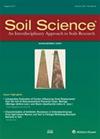土壤深度对人工林(辐射松)浮石土壤微生物和碳动态的影响
4区 农林科学
Q2 Agricultural and Biological Sciences
引用次数: 1
摘要
摘要森林土壤是调节全球碳(C)循环的基础;它们积累大量碳的能力意味着它们在缓解气候变化的影响方面发挥着至关重要的作用。了解调节森林土壤碳动态和稳定的过程对于最大限度地提高碳固存能力和寿命至关重要。与表层土壤相比,我们对深层(即30 cm以下土层)的土壤碳动态知之甚少。在估计全球土壤C储量分布和评估土壤C储量对气候变化的脆弱性时,这种知识差距造成了很大的不确定性。本研究旨在深入新西兰普鲁基实验森林的底土,并表征土壤C动态和土壤微生物组的变化,直至土壤深度1 m。采用ITS、16S rRNA测序和实时荧光定量PCR检测土壤微生物多样性、组成和丰度的变化。稳定(δ13C)和放射性(14C) C分析用于评估深度驱动的土壤C稳定性和年龄的变化。我们的研究发现,随着土壤深度的增加,微生物多样性和丰度大幅下降,同时群落成员的结构也发生了重大变化。重要的是,我们保守估计,超过35%的土壤C储量存在于30厘米以下的地下土层中。尽管土壤C的年龄随着深度的增加而稳步增加,在最深的土层中达到1571年BP(距今多年)的平均放射性碳年龄,但土壤C的稳定性在不同的底土深度增量之间存在差异。这些研究结果强调了量化地下碳储量对准确计算碳的重要性。通过执行广泛的分析措施,本研究全面表征了地下土壤环境的非生物和生物特性-这是森林生态系统中经常未得到充分研究但重要的组成部分。本文章由计算机程序翻译,如有差异,请以英文原文为准。
Soil depth as a driver of microbial and carbon dynamics in a planted forest (Pinus radiata) pumice soil
Abstract. Forest soils are fundamental in regulating the global carbon (C)
cycle; their capacity to accumulate large stores of C means they form a
vital role in mitigating the effects of climate change. Understanding the
processes that regulate forest soil C dynamics and stabilisation is
important to maximise the capacity and longevity of C sequestration.
Compared with surface soil layers, little is known about soil C dynamics in
subsoil layers, sensu those below 30 cm depth. This knowledge gap creates large
uncertainties when estimating the distribution of global soil C stocks and
assessing the vulnerability of soil C reserves to climate change. This study
aimed to dive deep into the subsoils of Puruki Experimental Forest (New
Zealand) and characterise the changes in soil C dynamics and the soil
microbiome down to 1 m soil depth. ITS and 16S rRNA sequencing and
quantitative real-time PCR were used to measure changes in soil microbial
diversity, composition, and abundance. Stable (δ13C) and
radioactive (14C) C analyses were performed to assess depth-driven
changes in the stability and age of soil C. Our research identified large
declines in microbial diversity and abundance with soil depth, alongside
significant structural shifts in community membership. Importantly, we
conservatively estimate that more than 35 % of soil C stocks are present in
subsoil layers below 30 cm. Although the age of soil C steadily increased
with depth, reaching a mean radiocarbon age of 1571 yr BP (years before
present) in the deepest soil layers, the stability of soil C varied between
different subsoil depth increments. These research findings highlight the
importance of quantifying subsoil C stocks for accurate C accounting. By
performing a broad range of analytical measures, this research has
comprehensively characterised the abiotic and biotic properties of a subsoil
environment – a frequently understudied but significant component of forest
ecosystems.
求助全文
通过发布文献求助,成功后即可免费获取论文全文。
去求助
来源期刊

Soil Science
农林科学-土壤科学
CiteScore
2.70
自引率
0.00%
发文量
0
审稿时长
4.4 months
期刊介绍:
Cessation.Soil Science satisfies the professional needs of all scientists and laboratory personnel involved in soil and plant research by publishing primary research reports and critical reviews of basic and applied soil science, especially as it relates to soil and plant studies and general environmental soil science.
Each month, Soil Science presents authoritative research articles from an impressive array of discipline: soil chemistry and biochemistry, physics, fertility and nutrition, soil genesis and morphology, soil microbiology and mineralogy. Of immediate relevance to soil scientists-both industrial and academic-this unique publication also has long-range value for agronomists and environmental scientists.
 求助内容:
求助内容: 应助结果提醒方式:
应助结果提醒方式:


